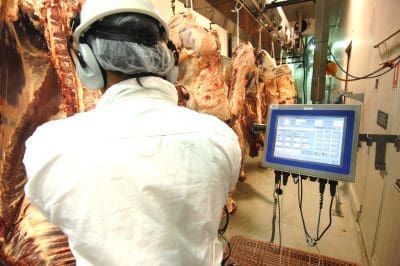AFTER setting a 2025 season high of almost 159,000 head a week earlier, rates of adult cattle slaughter reported by the National Livestock Reporting Service eased a little last week.
The seven-day kill ended Friday showed national throughput at 153,008 head, down almost 6000 head on the seasonal record the week before.
 Queensland represented by the far biggest part of that decline, falling more than 5300 on the prior week. There appears to be several reasons for the sizeable decline in the north – local annual show holidays in some Queensland processing regions; some additional boning shifts and Saturday rosters adding capacity the previous week; and one or two minor plant stoppages.
Queensland represented by the far biggest part of that decline, falling more than 5300 on the prior week. There appears to be several reasons for the sizeable decline in the north – local annual show holidays in some Queensland processing regions; some additional boning shifts and Saturday rosters adding capacity the previous week; and one or two minor plant stoppages.
It’s looking increasingly like the rates of national kill since mid June are approaching their physical threshold, given current labour levels, and may be about to tap-out. If that’s the case, the current weekly numbers are about 15,000 head per week higher than this time last year, when 140,000-145,000 was about the upper weekly limit.
High rates of national slaughter are being underpinned by unusually high production in southern states for this time of year. Victoria and South Australia normally show a substantial production decline during the depths of winter, but this year have remained higher than normal. Much of that is due to supplementation of cattle supply out of Queensland (the subject of a second story today).
At last week’s Dalby store sale, for example, southern processors bought half (some cattle buyers attending the sale suggest the number was much more than half) of the yarding of 1200 cows on offer. Another big yarding of 1700 cows at Roma today, and almost 1800 at Dalby tomorrow, are again likely to attract southern support, local agents suggest.
Despite last week’s smaller national slaughter throughput, it was still the third largest production week for this year, and represented a lift of 9.2pc on the same week 12 months ago. Keep in mind that the slaughter numbers recorded by NLRS are not mandatory, and there is a proportion (around 15pc) of cattle not accounted for in the tally. More important in the NLRS slaughter summary is the trend, rather than the outright number.
In round terms, it means last week’s true national adult cattle slaughter was more like 176,000, than the reported 153,000 head. More accurate, but less timely, ABS kill data will be available at the end of July.
 New South Wales also showed a small decline in production reported by NLRS last week, losing 890 head on the previous week to account for 36,689 head for the week ended Friday.
New South Wales also showed a small decline in production reported by NLRS last week, losing 890 head on the previous week to account for 36,689 head for the week ended Friday.
Victoria’s tally was up a couple of hundred, to 26,763 head. Remarkably, more than 76pc of those were females, partly reflecting the large number of northern cows being bought out of Queensland at present for processing in Victoria. In fact female slaughter ratio in Victoria has not fallen below 75pc for the past month.
While there are clearly some great oats crops around this year (see earlier report), Queensland processors suggest it will be at least another month before oats finished cattle start to appear on kill rosters. Frosts were late to arrive this winter, but have clearly taken a toll on pasture condition in some areas since mid-June. Processors have not yet seen a slide in carcase weights in slaughter cattle due to pasture condition, but that could start to appear by mid-August, one contact said.
Grid prices steady
Direct consignment slaughter grids appear to have found a level of stability across eastern and southern Australia as the new financial year gets started.
Apart from a few upwards adjustments on cows, most other descriptions and regions have shown little movement for a couple of weeks now.
Most Queensland processors are holding solid bookings out to the last week in July, and early August in some cases.
While some of those are unpriced (grid slots allocated only, with price to be negotiated closer to slaughter date), there has clearly been a shift in policy by some Queensland processors, now prepared to offer a price further out. One explanation for this may be the added competition evident for Queensland cattle at present from southern processors. One single Victorian processor bought 530 head on their own out of Roma sale last week.
Export processors in the southern regions of Queensland have over-the-hooks offers today with four-tooth grass ox on 620-630c/kg, and heavy cows 550-560c/kg.
Processors in the Central Queensland region are 520-530c/kg on heavy cows and 600-610c/kg on four-tooth heavy steer.
In southern states, grid offers are mostly steady this week. In eastern parts of South Australia, grids are showing 630c on heavy cows and 710c on four-tooth grass ox. Southern regions of NSW show best cows on 630c and four-tooth grass heavy steer 710c.
A specialist cow processor in southern NSW has a grid for heavy cows +300kg for delivery week commencing 14 July of 615c/kg, with lighter cows 275-300kg at 605c.
Saleyards channel
Some big yardings around this week could put pressure on current price levels.
Gunnedah sale is expected to yard around 3500 today, up 1200 on last week (no report yet available), Inverell also has a solid yarding, while Tamworth yesterday yarded almost 2200.
Tamworth market yesterday saw grown steers to process gain 6c/kg, selling from 330-390c/kg, while grown heifers sold from 312-355c/kg. Heavy cows were 9c/kg dearer selling from 262-342c, with restocker cows 257-283c/kg.
Wagga yesterday saw a moderate lift in supply. The market offered mainly store cattle, with only a few well-finished pens making their way into the export sale. Heavy steers and bullocks suitable for processors made from 360-406c/kg, while the cow market also gained traction as the sale progressed, with well-finished types becoming a priority for some processors. Heavy cows sold from 338-371c/kg, while leaner types fetched 224-357c/kg. Store cows were well supplied selling from 260-294c/kg.
Wodonga sale this morning yarded only 710 head, with cows again making up a fair portion of the offering, including grain assisted descriptions, which drew good interest from buyers. On the export front, well-bred steers 500-600kg were primarily purchased by feedlots, with prices ranging from 370-466c/kg. Heavy steers and bullocks destined for processors sold from 345-445c/kg. Heavy cows gained 5-6c, selling from 340-365c, leaner cows sold at stronger price trends prices, ranging from 240-318c/kg.

HAVE YOUR SAY